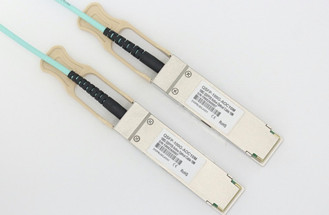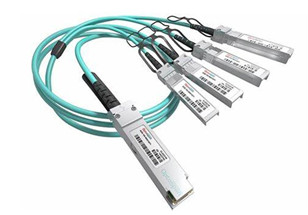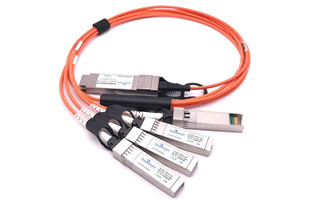
With the development of 100G Ethernet becoming a trend, the demand for 100G optical transceiver market is increasing, and now 100G optical transceiver accounts for a large proportion of network construction costs. Among these optical modules connected to 100G links, the 100G QSFP28 has become the preferred module for 100G due to its small size and low power consumption. What are the specific types of 100G QSFP28 modules and what are the differences between them? And how do you choose these modules? This article will take you closer to the 100G QSFP28 to understand the specific differences and connections between these modules.

1. What is QSFP28 optical module?
The 100G QSFP28 optical transceiver is suitable for 100G Ethernet, EDR InfiniBand, and 32G Fibre Channel and typically has exactly the same volume and panel density as 40G QSFP+. The 40G QSFP+ uses four 10Gbps lanes, and the 100G QSFP28 module is similar to it, using four high-speed differential signal lanes and supporting data rates of 25Gbps, possibly up to 40Gbps. In addition, the QSFP28 has an upgraded electrical interface capable of supporting signals up to 28Gbps. QSFP28 SR4、QSFP28 LR4、QSFP28 PSM4、QSFP28 CWDM4、QSFP28 ER4。 Compared with other package types of 100G optical transceivers (CFP/CFP2/CFP4), 100G QSFP28 has higher density, lower power consumption and obvious price advantages.

2, the difference between 100G QSFP28 optical modules
Now that you understand the basic concepts of 100G QSFP28, this section explains in detail the differences in standards, laser types, transmission media, and distances of 100G QSFP28 modules.
A. Standard for 100G QSFP28 optical transceivers
The standard of 100G QSFP28 optical transceiver is mainly defined by IEEE and MSA two major organizations, of which IEEE defines the QSFP28 SR4, QSFP28 LR4, QSFP28 ER4 standards. "QSFP" refers to the packaging of the optical module; "28" means that the maximum transmission rate per lane is 28Gbps; "SR" means short distance (up to 100m), "LR" means long distance (up to 10km), "ER" means extended distance (up to 40km); ''4' means that the module has 4 channels. For example, the QSFP28 LR4 means that the 100G long-range module can transmit 100G signals using four wavelengths for a distance of up to 10km.
100GBASE-SR4 and 100GBASE-LR4 are the two most common 100G port specifications defined by the IEEE, but the QSFP28 SR4 is too short to meet all connectivity requirements, and the QSFP28 LR4 is too expensive for large data centers. Fortunately, MSA brings new solutions to the mid-range transmission market: the QSFP28 PSM4 and CWDM4 standards are born. Although the QSFP28 LR4 covers the transmission distance of the QSFP28 CWDM4, the cost of CWDM4 in the 2km distance is far more affordable and competitive than that of LR4 in terms of cost.
B. 100G QSFP28 laser model
Lasers play a huge role in 100G QSFP28 optical modules, and there are five common lasers: VCSEL, FP, DFB, DML and EML. These different types of lasers have different operating wavelengths, operating modes, and application environments
| Laser type | Operating wavelength | Operating mode | Transmission distance |
| VCSEL | 850nm | Surface launch | <200m |
| FP | 1310nm/1550nm | Side launch | 500m-10km |
| DFB | 1310nm/1550nm | Side launch | 40km |
| DML | 1310nm/1550nm | Direct modulation | 500m-10km |
| EML | 1310nm/1550nm | Electrical absorption modulation | 40km |
VCSEL lasers are characterized by small size, low power consumption, easy integration, low cost, and high coupling efficiency with multimode fibers, commonly found in QSFP28 SR4 modules. The QSFP28 LR4 and ER4 modules are used for long-distance transmission (10km or 40km) and require lasers with large eye opening, low dispersion, high extinction ratio and long transmission distances, and EML lasers meet all the requirements. DML lasers achieve signal modulation by modulating the injection current of the laser. The magnitude of the injected current changes the refractive index of the active region of the laser, resulting in wavelength drift and thus dispersion. Therefore, DML is not suitable for long-distance transmission and cannot achieve high-rate signal modulation, but it is suitable for QSFP28 PSM4 and QSFP28 CWDM4 modules with transmission distances of 500m or 2km.
C. 100G QSFP28 transmission medium and distance
The 100G QSFP28 optical transceiver comes with duplex LC or MTP/MPO-12 connectors and transmits distances from 70m to 40km. The transmission distance of these optical modules determines their application scenarios, and all QSFP28 modules can be applied to direct connection and interconnection of enterprise networks or data centers. The following table shows the differences in detail.
| QSFP28 | SR4 | LR4 | PSM4 | CWDM4 | ER4 |
| Standard | IEEE 802.3 | IEEE 802.3 | MSA | MSA | IEEE 802.3 |
| Connector | MTP/MPO-12 | Duplex LC | MTP/MPO-12 | Duplex LC | Duplex LC |
| Fiber type | Multimode | Single Mode | Single Mode | Single Mode | Single Mode |
| Wavelength | 850nm | 1295.56-1309.14nm | 1310nm | 1271-1331nm | 1295.56-1309.14nm |
| Transmission distance | 70/100m | 10km | 500m | 2km | 40km |
| Launch Type | VCSEL | EML | DML/FP | DML | EML |
3. How to choose a 100G QSFP28 optical module?
After introducing different kinds of 100G QSFP28 modules, I believe you have a basic understanding of these modules, let's talk about how to choose 100G QSFP28 modules.
1. When the transmission distance is 5m-100m, it is recommended that you choose QSFP28 SR4 optical module, which can transmit distance of 70m on OM3 fiber and 100m on OM4 fiber.
2. When the transmission distance is 100m-2km, you can choose QSFP28 PSM4 or QSFP28 CWDM4 module. The unit price of CWDM4 is generally higher than that of PSM4, but CWDM4 only needs 2 single-mode fibers for bidirectional transmission, while PSM4 requires 8, so the overall cost of using QSFP28 PSM4 may be more expensive. Therefore, in practical applications, it is necessary to consider the specific transmission distance and then decide which module is suitable.
3. When the transmission distance is 10km-40km, choose QSFP28 LR4 or QSFP28 ER4, the former can transmit up to 10km, the latter can transmit up to 40km.

Overall, the 100G QSFP28 has the characteristics of high density and low power consumption, which can meet current network requirements while preparing for future network expansion, making it an ideal optical transceiver solution for large data centers. FS offers a wide range of high-performance 100G QSFP28 optical modules, all of which are rigorously tested to ensure product quality and compatibility


